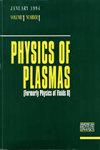利用深度神经网络进行折射增强型 X 射线放射摄影的相位检索
IF 2.2
3区 物理与天体物理
Q3 PHYSICS, FLUIDS & PLASMAS
引用次数: 0
摘要
X 射线折射增强射线照相术(RER)或相位对比成像被广泛用于研究材料内部的不连续性。由此产生的射线照片既能捕捉到材料沿 X 射线路径吸收所导致的强度下降,也能捕捉到对密度梯度高度敏感的相移。有效分析射线照片,将强度和相位信息解耦,并准确确定密度剖面是一项重大挑战。由于难以纳入物理约束和其他相关信息,传统算法通常会产生模糊和不切实际的结果。我们开发了一种使用深度神经网络来解决这些问题的算法,并将其应用于从实验 RER 中提取详细的密度曲线。为了推广我们算法的适用性,我们开发了一种技术,可根据样本的特征和实验的配置,定量评估相位检索过程的复杂性。因此,这种评估有助于为每种特定情况选择神经网络架构。除 RER 外,该模型还有可能应用于其他需要进行相位检索分析的诊断。本文章由计算机程序翻译,如有差异,请以英文原文为准。
Phase retrieval for refraction-enhanced x-ray radiography using a deep neural network
X-ray refraction-enhanced radiography (RER) or phase contrast imaging is widely used to study internal discontinuities within materials. The resulting radiograph captures both the decrease in intensity caused by material absorption along the x-ray path, as well as the phase shift, which is highly sensitive to gradients in density. A significant challenge lies in effectively analyzing the radiographs to decouple the intensity and phase information and accurately ascertain the density profile. Conventional algorithms often yield ambiguous and unrealistic results due to difficulties in including physical constraints and other relevant information. We have developed an algorithm that uses a deep neural network to address these issues and applied it to extract the detailed density profile from an experimental RER. To generalize the applicability of our algorithm, we have developed a technique that quantitatively evaluates the complexity of the phase retrieval process based on the characteristics of the sample and the configuration of the experiment. Accordingly, this evaluation aids in the selection of the neural network architecture for each specific case. Beyond RER, the model has potential applications for other diagnostics where phase retrieval analysis is required.
求助全文
通过发布文献求助,成功后即可免费获取论文全文。
去求助
来源期刊

Physics of Plasmas
物理-物理:流体与等离子体
CiteScore
4.10
自引率
22.70%
发文量
653
审稿时长
2.5 months
期刊介绍:
Physics of Plasmas (PoP), published by AIP Publishing in cooperation with the APS Division of Plasma Physics, is committed to the publication of original research in all areas of experimental and theoretical plasma physics. PoP publishes comprehensive and in-depth review manuscripts covering important areas of study and Special Topics highlighting new and cutting-edge developments in plasma physics. Every year a special issue publishes the invited and review papers from the most recent meeting of the APS Division of Plasma Physics. PoP covers a broad range of important research in this dynamic field, including:
-Basic plasma phenomena, waves, instabilities
-Nonlinear phenomena, turbulence, transport
-Magnetically confined plasmas, heating, confinement
-Inertially confined plasmas, high-energy density plasma science, warm dense matter
-Ionospheric, solar-system, and astrophysical plasmas
-Lasers, particle beams, accelerators, radiation generation
-Radiation emission, absorption, and transport
-Low-temperature plasmas, plasma applications, plasma sources, sheaths
-Dusty plasmas
 求助内容:
求助内容: 应助结果提醒方式:
应助结果提醒方式:


